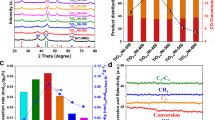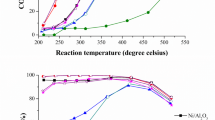Abstract
Low-temperature methanation allows the near-equilibrium conversion of CO2 to methane at atmospheric pressure, promising remarkable energy efficiency and economic interests. However, it remains challenging for the efficient catalytic activation of CO2 at low temperature owing to the kinetic limitations of hydrogenation intermediates. Here we report that Ni-based inverse catalysts composed of oxide nano-islands loaded on metallic Ni support show significant activity advantages over traditional Ni/oxide with the same composition. The optimized CeZrOx/Ni catalyst realizes ~90% CO2 conversion and >99% CH4 selectivity at 200 °C and atmospheric pressure; it also exhibits excellent long-term stability and overheating/start–stop cyclic operation stability. Mechanistic studies show that the inverse interface effectively modulates H2 and CO2 coverage and alters the configuration of adsorbed oxygenates, which benefits the hydrogenation of surface intermediates. Energy and economic analyses demonstrate that the low-temperature CO2 methanation process powered by inverse catalysts potentially reduces both capital investment and methane production costs.

This is a preview of subscription content, access via your institution
Access options
Subscribe to this journal
Receive 12 digital issues and online access to articles
$119.00 per year
only $9.92 per issue
Buy this article
- Purchase on SpringerLink
- Instant access to full article PDF
Prices may be subject to local taxes which are calculated during checkout





Similar content being viewed by others
Data availability
All data are available within the Article and its Supplementary Information. The atomic coordinates of the optimized computational models are provided in Supplementary Data 1. Source data are provided with this paper.
References
Marques Mota, F. et al. From CO2 methanation to ambitious long-chain hydrocarbons: alternative fuels paving the path to sustainability. Chem. Soc. Rev. 48, 205–259 (2019).
Chu, S. et al. Opportunities and challenges for a sustainable energy future. Nature 488, 294–303 (2012).
Gan, Y. et al. Carbon footprint of global natural gas supplies to China. Nat. Commun. 11, 824 (2020).
Tébar-Soler, C. et al. Low-oxidation-state Ru sites stabilized in carbon-doped RuO2 with low-temperature CO2 activation to yield methane. Nat. Mater. 22, 762–768 (2023).
Zou, T. et al. ZnO-promoted inverse ZrO2–Cu catalysts for CO2-based methanol synthesis under mild conditions. ACS Sustain. Chem. Eng. 10, 81–90 (2021).
Jiang, H. et al. Light-driven CO2 methanation over Au-grafted Ce0.95Ru0.05O2 solid-solution catalysts with activities approaching the thermodynamic limit. Nat. Catal. 6, 519–530 (2023).
Das, S. et al. Core–shell structured catalysts for thermocatalytic, photocatalytic, and electrocatalytic conversion of CO2. Chem. Soc. Rev. 49, 2937–3004 (2020).
Yang, C. et al. Intrinsic mechanism for carbon dioxide methanation over ru-based nanocatalysts. ACS Catal. 13, 11556–11565 (2023).
Aitbekova, A. et al. Low-temperature restructuring of CeO2-supported Ru nanoparticles determines selectivity in CO2 catalytic reduction. J. Am. Chem. Soc. 140, 13736–13745 (2018).
Vogt, C. et al. The renaissance of the Sabatier reaction and its applications on Earth and in space. Nat. Catal. 2, 188–197 (2019).
Lee, Y. H. et al. Role of oxide support in Ni based catalysts for CO2 methanation. RSC Adv. 11, 17648–17657 (2021).
Vogt, C. et al. Publisher Correction: Unravelling structure sensitivity in CO2 hydrogenation over nickel. Nat. Catal. 1, 163–163 (2018).
Vogt, C. et al. Dynamic restructuring of supported metal nanoparticles and its implications for structure insensitive catalysis. Nat. Commun. 12, 7096 (2021).
Lin, L. et al. Effect of Ni particle size on the production of renewable methane from CO2 over Ni/CeO2 catalyst. J. Energy Chem. 61, 602–611 (2021).
Struijs, J. J. C. et al. Ceria-supported cobalt catalyst for low-temperature methanation at low partial pressures of CO2. Angew. Chem. Int. Ed. 62, e202214864 (2023).
Parastaev, A. et al. Boosting CO2 hydrogenation via size-dependent metal–support interactions in cobalt/ceria-based catalysts. Nat. Catal. 3, 526–533 (2020).
Li, S. et al. Iron carbides: control synthesis and catalytic applications in COx hydrogenation and electrochemical HER. Adv. Mater. 31, 1901796 (2019).
Zhang, Z. et al. Eu3+ doping-promoted Ni–CeO2 interaction for efficient low-temperature CO2 methanation. Appl. Catal. B 317, 121800 (2022).
Ren, J. et al. Promotional effects of Ru and Fe on Ni/ZrO2 catalyst during CO2 methanation: a comparative evaluation of the mechanism. J. Energy Chem. 86, 351–361 (2023).
Aziz, M. A. A. et al. CO2 methanation over Ni-promoted mesostructured silica nanoparticles: influence of Ni loading and water vapor on activity and response surface methodology studies. Chem. Eng. J. 260, 757–764 (2015).
De Masi, D. et al. Engineering iron–nickel nanoparticles for magnetically induced CO2 methanation in continuous flow. Angew. Chem. Int. Ed. 59, 6187–6191 (2020).
Li, J. et al. Enhanced CO2 methanation activity of Ni/anatase catalyst by tuning strong metal–support interactions. ACS Catal. 9, 6342−–66348 (2019).
Ye, R. et al. Boosting low-temperature CO2 hydrogenation over Ni-based catalysts by tuning strong metal–support interactions. Angew. Chem. Int. Ed. 63, e202317669 (2024).
Ma, L. et al. Enhanced low-temperature CO2 methanation performance of Ni/ZrO2 catalysts via a phase engineering strategy. Chem. Eng. J. 446, 137031 (2022).
Wu, C. et al. Inverse ZrO2/Cu as a highly efficient methanol synthesis catalyst from CO2 hydrogenation. Nat. Commun. 11, 5767 (2020).
Liu, X. et al. In situ spectroscopic characterization and theoretical calculations identify partially reduced ZnO1−x/Cu interfaces for methanol synthesis from CO2. Angew. Chem. Int. Ed. 61, e202202330 (2022).
Xu, Y. et al. Cu-supported nano-ZrZnOx as a highly active inverse catalyst for low temperature methanol synthesis from CO2 hydrogenation. Appl. Catal. B 344, 123656 (2024).
Xu, Y. et al. Insights into the interfacial structure of Cu/ZrO2 catalysts for methanol synthesis from CO2 hydrogenation: effects of Cu-supported nano-ZrO2 inverse interface. Chem. Eng. J. 470, 144006 (2023).
Alarcón, A. et al. Optimization of nickel and ceria catalyst content for synthetic natural gas production through CO2 methanation. Fuel Process. Technol. 193, 114–122 (2019).
Wang, C. et al. Nickel catalyst stabilization via graphene encapsulation for enhanced methanation reaction. J. Catal. 334, 42–51 (2016).
Xu, X. et al. Facile Cr3+-doping strategy dramatically promoting Ru/CeO2 for low-temperature CO2 methanation: unraveling the roles of surface oxygen vacancies and hydroxyl groups. ACS Catal. 11, 5762–5775 (2021).
Navarro-Jaén, S. et al. Size-tailored Ru nanoparticles deposited over γ-Al2O3 for the CO2 methanation reaction. Appl. Surf. Sci. 483, 750–761 (2019).
Zhang, Y. et al. Ru/TiO2 catalysts with size-dependent metal/support interaction for tunable reactivity in Fischer–Tropsch synthesis. ACS Catal. 10, 12967–12975 (2020).
Zhao, Z. et al. Effect of rutile content on the catalytic performance of Ru/TiO2 catalyst for low-temperature CO2 methanation. ACS Sustain. Chem. Eng. 9, 14288–14296 (2021).
Ashok, J. et al. A review of recent catalyst advances in CO2 methanation processes. Catal. Today 356, 471–489 (2020).
Gao, J. et al. Recent advances in methanation catalysts for the production of synthetic natural gas. RSC Adv. 5, 22759–22776 (2015).
Yang, J. et al. A hydrothermally stable irreducible oxide-modified Pd/MgAl2O4 catalyst for methane combustion. Angew. Chem. Int. Ed. 59, 18522–18526 (2020).
Wang, X.-F. et al. WO3 boosted water tolerance of Pt nanoparticle on SO42−–ZrO2 for propane oxidation. Appl. Catal. B 338, 123000 (2023).
Hu, B. et al. Distinct crystal-facet-dependent behaviors for single-atom palladium-on-ceria catalysts: enhanced stabilization and catalytic properties. Adv. Mater. 34, 2107721 (2022).
Feng, W.-H. et al. Insights into bimetallic oxide synergy during carbon dioxide hydrogenation to methanol and dimethyl ether over GaZrOx oxide catalysts. ACS Catal. 11, 4704–4711 (2021).
Zhang, J. et al. Engineering Cu+/CeZrOx interfaces to promote CO2 hydrogenation to methanol. J. Energy Chem. 77, 45–53 (2023).
Lee, K. et al. Engineering nanoscale H supply chain to accelerate methanol synthesis on ZnZrOx. Nat. Commun. 14, 819 (2023).
Zhao, H. et al. The role of Cu1–O3 species in single-atom Cu/ZrO2 catalyst for CO2 hydrogenation. Nat. Catal. 5, 818–831 (2022).
Wang, C. et al. Ru-based catalysts for efficient CO2 methanation: synergistic catalysis between oxygen vacancies and basic sites. Nano Res. 16, 12153–12164 (2023).
Xie, Y. et al. Frustrated Lewis pairs boosting low-temperature CO2 methanation performance over Ni/CeO2 nanocatalysts. ACS Catal. 12, 10587–10602 (2022).
Tan, T. H. et al. Unlocking the potential of the formate pathway in the photo-assisted Sabatier reaction. Nat. Catal. 3, 1034–1043 (2020).
Tripodi, A. et al. Carbon dioxide methanation: design of a fully integrated plant. Energy Fuels 34, 7242–7256 (2020).
Peters, M. S. et al. Plant Design and Economics for Chemical Engineers (McGraw-Hill, 2003).
Tang, X. et al. Thermally stable Ni foam-supported inverse CeAlOx/Ni ensemble as an active structured catalyst for CO2 hydrogenation to methane. Nat. Commun. 15, 3115 (2024).
Kresse, G. et al. Efficiency of ab-initio total energy calculations for metals and semiconductors using a plane-wave basis set. Comput. Mater. Sci. 6, 15–50 (1996).
Kresse, G. et al. Efficient iterative schemes for ab initio total-energy calculations using a plane-wave basis set. Phys. Rev. B 54, 11169 (1996).
Perdew, J. P. et al. Generalized gradient approximation made simple. Phys. Rev. Lett. 77, 3865 (1996).
Blöchl, P. E. Projector augmented-wave method. Phys. Rev. B 50, 17953 (1994).
Monkhorst, H. J. et al. Special points for Brillouin-zone integrations. Phys. Rev. B 13, 5188 (1976).
Nosé, S. A unified formulation of the constant temperature molecular dynamics methods. J. Chem. Phys. 81, 511–519 (1984).
Hoover, W. G. Canonical dynamics: equilibrium phase-space distributions. Phys. Rev. A 31, 1695 (1985).
Acknowledgements
This work is financially supported by the Zhejiang Provincial Natural Science Foundation of China (LR22B030003, L.L.; LQ24B030016, C.S.), Natural Science Foundation of China (22278367, L.L.), China Postdoctoral Science Foundation Grant (2022M712817, C.S.), Research Fund of Department of Education of Zhejiang Province (Y202249632, L.L.), National Natural Science Foundation of China 22232001 (D.M.), National Key R&D Program of China 2021YFA1501102 (D.M.), XPLORER Prize of Tencent Foundation (D.M.), New Cornerstone Science Foundation of Tencent Foundation (D.M.), Natural Science Foundation of China (22225206, X.W.), Natural Science Foundation of China (22202224, J.L.) and the Project of National Natural Science Foundation of China (U22A20415, Z.L.).
Author information
Authors and Affiliations
Contributions
L.L., D.M. and X.L. designed the study. C.S. and X.T. performed most of the reactions. X.T. and H. Lu carried out the stability experiments. J.L. and X.-D.W. performed the DFT calculations. R.W. and Z.L. performed the energy and economy analyses. K.W., Z.G. and F.Y. performed the TEM characterization. C.S. and H. Li carried out the DRIFTS analysis. C.S., L.L., S.Y. and M.P. wrote the paper. All authors discussed and revised the paper.
Corresponding authors
Ethics declarations
Competing interests
The authors declare no competing interests.
Peer review
Peer review information
Nature Chemical Engineering thanks Patricia Concepcion, Atsushi Urakawa and the other, anonymous, reviewer(s) for their contribution to the peer review of this work.
Additional information
Publisher’s note Springer Nature remains neutral with regard to jurisdictional claims in published maps and institutional affiliations.
Supplementary information
Supplementary Information
Supplementary Figs. 1–28, Discussion and Tables 1–15.
Supplementary Data 1
Atomic coordinates of the optimized computational models
Source data
Source Data Fig. 1
Statistical source data.
Source Data Fig. 2
Statistical source data.
Source Data Fig. 3
Statistical source data.
Source Data Fig. 4
Statistical source data.
Source Data Fig. 5
Statistical source data.
Rights and permissions
Springer Nature or its licensor (e.g. a society or other partner) holds exclusive rights to this article under a publishing agreement with the author(s) or other rightsholder(s); author self-archiving of the accepted manuscript version of this article is solely governed by the terms of such publishing agreement and applicable law.
About this article
Cite this article
Song, C., Liu, J., Wang, R. et al. Engineering MOx/Ni inverse catalysts for low-temperature CO2 activation with high methane yields. Nat Chem Eng 1, 638–649 (2024). https://doi.org/10.1038/s44286-024-00122-5
Received:
Accepted:
Published:
Issue date:
DOI: https://doi.org/10.1038/s44286-024-00122-5



